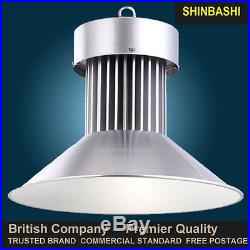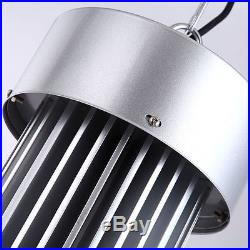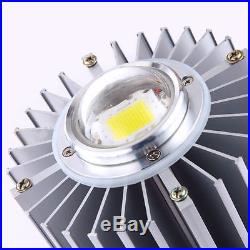


Premium LED High Bay Light COB 30-300W Pure White 5000K. 120 Degree or 90 Degree (optional). LOOKING FOR OTHER HIGH BAY LIGHTS, PLEASE VISIT OUR SHOP. LED’s use less electricity, fewer power outlets are required, lowering the electrical costs for setup. 648 Large LEDs =. = less than half of a standard bulb. LED (Light Emitting Diode) is the next generation of lighting technology and design, rapidly becoming the preferred lighting solution of both professionals and consumers. An LED “bulb” is a small solid state lighting device comprised of a tiny semiconductor diode encapsulated in an epoxy resin enclosure that glows when voltage is applied to it. This unique method of generating light output provides LEDs with a variety of advantages including energy-efficiency, longevity, durability and safety. In today’s power-hungry world, “energy efficiency” is becoming an increasingly important term as we strive to find new ways to lower our overall consumption of power. New technologies are being developed to increase our efficiency. No doubt, you’ve heard of the new technologies in the automotive industry that are helping lead it into a cleaner future such as the hybrid car, E85 gasoline, and the hydrogen fuel cell vehicle. The lighting industry is also experiencing similar design and technological breakthroughs which will guide it into a more-efficient, less power-hungry future. One of the key technologies breaking through is the use of LEDs. Consuming up to 90% less power than your standard incandescent light bulb, LEDs are an extremely energy efficient technology. Lower power consumption means lower energy bills. So not only are LEDs Eco-friendly, they can be wallet-friendly too. Here’s a real-world example for you on the efficiency of LED: our LED rope lights use 0.8 watts per linear foot of rope light. Compare that to a standard rope light which will use approximately 5-6 watts per linear foot. Now factor in the overall length of the rope light and how long it will stay on every day and it quickly becomes apparent how fast the energy saving features of LED technology can add up, both on your energy meter and your checkbook. LED Rope Light: 0.8 watts/ft 150 ft run = 120 watts Standard Rope Light: 6 watts/ft 150 ft run = 900 watts Versus LED, the Standard Rope Light consumes over 9X as much energy! The typical life span of an LED is 100,000 hours, compared to a typical incandescent bulb which has a life span of approximately 800-900 hours. The long life span of LEDs can dramatically reduce maintenance and long-term operating costs. Here is a breakdown of potential LED life spans: 100,000 hours powered for 24 hours/day = 11.5 years 100,000 hours powered for 8 hours/day = 34 years 100,000 hours powered for 4 hours/day = 68.5 years. Thanks to its electrical semiconductor and solid epoxy resin construction, LEDs do not contain fragile components like those found in incandescent or fluorescent bulbs such as glass, filaments or gases that are easily broken or disrupted. This makes LED a remarkably durable and rugged technology capable of withstanding shock, vibration and even extreme temperatures. Safety As the electrical semiconductor in an LED emits light, it will generate virtually no heat output and is cool to the touch. Leaving it on for an extended period of time can also be done without incident or worry. This is very different from incandescent light bulbs, where it is the heating of the filament that generates light. In fact, of all the energy incandescent bulbs consume, 95% of it is wasted on heat output. This why they are very hot to the touch and can become possible fire hazards. The Cost of Color. In the lighting world, LED is a state-of-the-art technology and with that comes a higher cost in manufacturing. But there are many advantages to using LEDs which can help offset their initial higher price, including that they are cheaper in the long run to operate due to energy savings and low maintenance costs. As for the price difference among colors, we first need to understand how color is produced in standard lighting products. In standard incandescent lighting, color is achieved by using different color filters over the light. No matter what color you choose, it’s still the same light bulb underneath, which is why there is no cost difference among colors. With LED however, it is the diode itself that emits the intended color, without the use of color filters. For this reason, each LED color is fabricated from a variety of different semiconductor materials to achieve the desired color. As a result, the variation in prices for these different materials determine the prices for particular colors. Another reason is due to some manufacturing processes used to generate the colors themselves. For example, white is typically the most expensive LED to produce. This is because in some LED applications, it is generated by combining a red, green, and a blue LED together to make white… Similar to the additive color theory “RGB” that most monitors and televisions use to create their white. The item “LED High Bay Light COB 150,200,240W Warehouse Commercial Industrial Lamp VAT UK” is in sale since Wednesday, January 20, 2016. This item is in the category “Business, Office & Industrial\Building Materials & Supplies\Lights & Lighting”. The seller is “support_team2000″ and is located in UK Based Firm, Commercial Standard. This item can be shipped to all countries in Europe, Australia, United States, Canada, Japan, New Zealand, China, Israel, Hong Kong, Indonesia, Malaysia, Mexico, Singapore, South Korea, Taiwan, Thailand, Chile.
- Type: LED
- Brand: SHINBASHI
- MPN: Does Not Apply